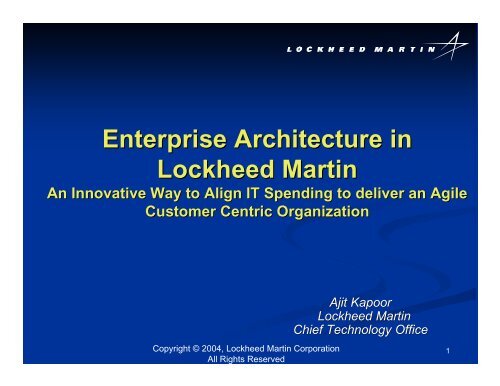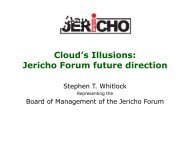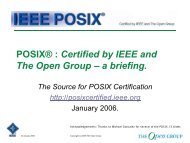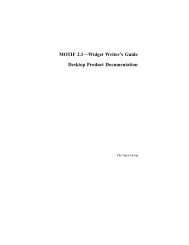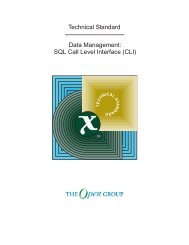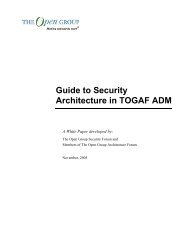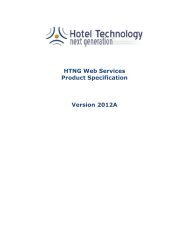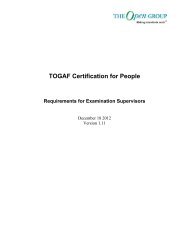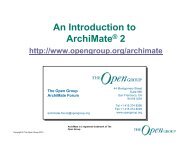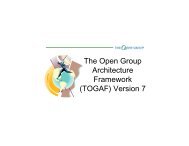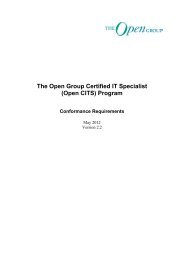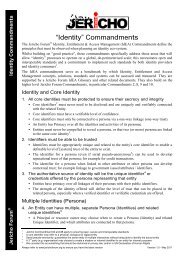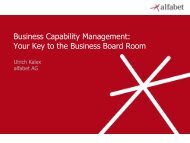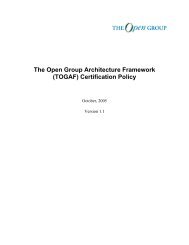Enterprise Architecture in Lockheed Martin - The Open Group
Enterprise Architecture in Lockheed Martin - The Open Group
Enterprise Architecture in Lockheed Martin - The Open Group
Create successful ePaper yourself
Turn your PDF publications into a flip-book with our unique Google optimized e-Paper software.
<strong>Enterprise</strong> <strong>Architecture</strong> <strong>in</strong><br />
<strong>Lockheed</strong> Mart<strong>in</strong><br />
An Innovative Way to Align IT Spend<strong>in</strong>g to deliver an Agile<br />
Customer Centric Organization<br />
Copyright © 2004, <strong>Lockheed</strong> Mart<strong>in</strong> Corporation<br />
All Rights Reserved<br />
Ajit Kapoor<br />
<strong>Lockheed</strong> Mart<strong>in</strong><br />
Chief Technology Office<br />
1
LM EA Executive Support<br />
Joseph R. Cleveland, Chief Information Officer. <strong>Lockheed</strong> Mart<strong>in</strong> Corporation; President,<br />
<strong>Lockheed</strong> Mart<strong>in</strong> <strong>Enterprise</strong> Information Systems<br />
April 21, 2004 2
LM Customer Mandate<br />
• <strong>The</strong> Cl<strong>in</strong>ger Cohen Act and the<br />
presidential mandate<br />
• <strong>The</strong> NASCIO commitment<br />
• OMB requirement for all<br />
government purchases<br />
• Start<strong>in</strong>g <strong>in</strong> 2004, federal agencies<br />
must correlate their budget<br />
submissions with their<br />
<strong>Enterprise</strong> <strong>Architecture</strong>s<br />
• Sarbanes-Oxley Compliance<br />
• UID Initiative- January 2005<br />
April 21, 2004 3
Our Mission <strong>in</strong> IT<br />
“Magnify the Power of<br />
<strong>Lockheed</strong> Mart<strong>in</strong><br />
through IT”<br />
April 21, 2004 4
Bus<strong>in</strong>ess/Technology Pendulum<br />
Bus<strong>in</strong>ess Strategy<br />
Technology<br />
Information <strong>Architecture</strong><br />
<strong>Architecture</strong><br />
Policies and Governance<br />
April 21, 2004 5
A Brief History<br />
• LM EA is new, but LM ‘A’ is not !<br />
• ITAF<br />
• BRM, TRM<br />
• We have leveraged EA Evolution<br />
Corporate<br />
Hardware<br />
Foundation<br />
Services<br />
Operat<strong>in</strong>g System Services<br />
Security Services<br />
System and Network Management Services<br />
Application,<br />
Presentation<br />
Applications Development<br />
Applications<br />
Workgroup, and<br />
Services<br />
Services<br />
Collaboration<br />
And Application<br />
Services<br />
Enabl<strong>in</strong>g<br />
Services<br />
Data<br />
Applications<br />
Object Component<br />
Services<br />
Interchange<br />
Services<br />
Data Management Services<br />
Distributed<br />
System<br />
Connectivity<br />
Object Management<br />
Distribution<br />
Services<br />
Services<br />
Support Services<br />
Services<br />
Common Transport Semantics<br />
Signal<strong>in</strong>g<br />
Transport Services<br />
and Control<br />
Communication<br />
Services<br />
Network Services<br />
Sub-Network<strong>in</strong>g<br />
Physical Network<br />
System and Network Management Services<br />
Security Services<br />
Operat<strong>in</strong>g System Services<br />
Hardware<br />
Application Systems<br />
- Corporate Systems<br />
- Computer<br />
-aided<br />
Software Eng<strong>in</strong>eer<strong>in</strong>g<br />
(CASE)<br />
- Product Data<br />
- Computer<br />
-aided<br />
Management (PDM)<br />
Manufactur<strong>in</strong>g<br />
(CAM)<br />
- <strong>Enterprise</strong> Resources<br />
-Manufactur<strong>in</strong>g<br />
Plann<strong>in</strong>g (ERP)<br />
Execution System<br />
(MES)<br />
- Computer<br />
-aided<br />
- Computer<br />
-aided<br />
Design/Eng<strong>in</strong>eer<strong>in</strong>g<br />
Ma<strong>in</strong>tenanceMgt<br />
.<br />
(CAD/CAE)<br />
April 21, 2004 6<br />
Operations<br />
Software<br />
Product Product Elements<br />
Elements<br />
Program/<br />
Operations<br />
Management<br />
Supp . Equip.<br />
Equip.<br />
Electronics<br />
Company<br />
Bus.Mgt.<br />
Bus.Mgṭ<br />
Structures<br />
Bus. Mgṭ<br />
Sector/<strong>Group</strong><br />
Bus.Mgṫ<br />
Product Def<strong>in</strong>ition<br />
Def<strong>in</strong>ition<br />
Market<strong>in</strong>g<br />
F<strong>in</strong>ance<br />
Legal<br />
Cost Management<br />
Schedule Management<br />
Quality Management<br />
Configuration Management<br />
Process Def<strong>in</strong>ition<br />
Logistics Management<br />
Systems Eng<strong>in</strong>eer<strong>in</strong>g<br />
Inbound Logistics<br />
Material Mgt.<br />
Mgt.<br />
Faḅ/Assem.<br />
Outbound Logistics<br />
Ma<strong>in</strong>tenance<br />
Ma<strong>in</strong>tenance<br />
Bus<strong>in</strong>ess Functions<br />
Human Resources
Architectural Frameworks<br />
C4ISR<br />
TEAF<br />
FEA<br />
TAFIM<br />
Zachman Model<br />
TOGAF v<br />
7<br />
TOGAF v<br />
8<br />
TOGAF v<br />
8.1<br />
April 21, 2004 7
Insertion Why of New Now?<br />
Technology<br />
Requires Managed Chaos<br />
• Our Customer Wants It<br />
• EA is now viewed as bus<strong>in</strong>ess driven and<br />
supported by the mathematics of “complex<br />
systems”<br />
April 21, 2004 8
What is the Spirit of the Mandate?<br />
q Complex Organization can’t be managed ad-hoc<br />
q We have to Leverage the Legacy<br />
q We must deploy new technologies to ma<strong>in</strong>ta<strong>in</strong><br />
competitive advantage<br />
q We need a holistic way to <strong>in</strong>tegrate now with the<br />
past and still be capable of adapt<strong>in</strong>g to the future<br />
q Agility to deliver the right <strong>in</strong>formation at the right<br />
time = Knowledge<br />
q All of this must be done based on<br />
Bus<strong>in</strong>ess/Customer demand-agility<br />
agility<br />
April 21, 2004 9
Clos<strong>in</strong>g the IT Bus<strong>in</strong>ess Chasm<br />
Bus<strong>in</strong>ess needs a new<br />
way of strategic th<strong>in</strong>k<strong>in</strong>g<br />
IT needs to align spend<strong>in</strong>g<br />
with bus<strong>in</strong>ess needs<br />
People<br />
CMMI<br />
ITIL<br />
Technology<br />
EA<br />
Process<br />
April 21, 2004 10
Align<strong>in</strong>g our IT Strategy<br />
• Bus<strong>in</strong>ess Goals<br />
with Bus<strong>in</strong>ess Goals<br />
• Right <strong>in</strong>formation to the Right people<br />
• Collaboration between partners<br />
• Integrated supply cha<strong>in</strong> (Eng- Mfs- Mkt/Dst-Support)<br />
• Tech Solutions<br />
• Portals<br />
• Web Services<br />
• EAI<br />
• PKI/Directory Services/Systems Management<br />
We created solutions that work part of the time-lacks horizontal <strong>in</strong>tegration!<br />
April 21, 2004 11
Align<strong>in</strong>g our IT Strategy<br />
• <strong>The</strong> Problem:<br />
with Bus<strong>in</strong>ess Goals<br />
• We have built a new layer of silos<br />
• From vertical to <strong>in</strong>ternet silos<br />
• Solutions<br />
• Use Internet Technology<br />
• Loosely Coupled<br />
• Component Based Development<br />
• Service Orientation<br />
• Mach<strong>in</strong>e to Mach<strong>in</strong>e Interaction Without Human<br />
Intervention<br />
April 21, 2004 12
Web Services are<br />
Beyond SOAP, UDDI, WSDL<br />
It’s All about the Service Grid<br />
• How do we build a<br />
loosely coupled<br />
federation of<br />
components that can<br />
be at run time<br />
orchestrated<br />
• Keep IT “Out of the<br />
Process”<br />
• Keep IT to build Solid<br />
Infrastructure for SOA<br />
Need a holistic way to look at the complex problem – Enter EA!<br />
From<br />
Stovepipe<br />
Fat<br />
App<br />
Bus<strong>in</strong>ess<br />
Logic<br />
Data<br />
Web Stovepipe<br />
Browser<br />
Browser<br />
HTML<br />
Web/App<br />
Server<br />
Servlet/COM<br />
Components<br />
Bus<strong>in</strong>ess<br />
Logic<br />
Data<br />
Information Services<br />
Fat<br />
App<br />
Web Server<br />
App Server<br />
Web Services<br />
Wrapped<br />
Servlet/COM<br />
Components<br />
Bus<strong>in</strong>ess<br />
Logic<br />
Browser<br />
To<br />
Interoperability<br />
Portal<br />
HTML/XML<br />
mach<strong>in</strong>e-consumer<br />
HTML/XML<br />
mach<strong>in</strong>e-mach<strong>in</strong>e<br />
XML<br />
XML<br />
PDA<br />
Phone<br />
Web Server<br />
App Server<br />
Web Services<br />
Servlet/COM<br />
Components<br />
Information Services<br />
Bus<strong>in</strong>ess<br />
Logic<br />
April 21, 2004 13
<strong>The</strong> Role of EA<br />
<strong>The</strong> EA Discipl<strong>in</strong>e is required to manage the complexity<br />
<strong>in</strong>troduced by the core of WS-<strong>The</strong> Service Grid.<br />
April 21, 2004 14
April 21, 2004 15<br />
Source: Cap Gem<strong>in</strong>i Ernst &Young
<strong>Enterprise</strong> <strong>Architecture</strong><br />
A well-designed enterprise architecture is the s<strong>in</strong>gle<br />
biggest technological contributor to bus<strong>in</strong>ess<br />
agility. An <strong>Enterprise</strong> <strong>Architecture</strong> ensures that<br />
essential <strong>in</strong>frastructure is <strong>in</strong> place such that LM can<br />
successfully harness its assets to foster cont<strong>in</strong>uous<br />
bus<strong>in</strong>ess <strong>in</strong>novation and growth. With a focus on<br />
bus<strong>in</strong>ess goals, architectural changes need to be<br />
implemented <strong>in</strong> conjunction with bus<strong>in</strong>ess-critical<br />
<strong>in</strong>itiatives to ensure valuable changes to the<br />
organization.<br />
At its most fundamental level, an enterprise<br />
architecture serves as a bluepr<strong>in</strong>t for a company’s<br />
most critical bus<strong>in</strong>ess processes:<br />
>support<strong>in</strong>g applications and data<br />
>software and hardware <strong>in</strong>frastructure<br />
>knowledge and expertise<br />
April 21, 2004 16
LM Challenge: Align<strong>in</strong>g<br />
IT to the Bus<strong>in</strong>ess<br />
<strong>Lockheed</strong> Mart<strong>in</strong><br />
Corporate<br />
<strong>Enterprise</strong><br />
Services<br />
Aeronautics<br />
Info. & Tech. Sys.<br />
Space Systems<br />
Electronic Sys.<br />
ISS<br />
Site <strong>Enterprise</strong><br />
And Workgroup<br />
Services<br />
Product<br />
Focus<br />
Operations<br />
Management<br />
Operations<br />
30+ Bus<strong>in</strong>ess Units, 60+ <strong>Enterprise</strong> Sites<br />
970+ Other<br />
Facilities<br />
Worldwide<br />
Small Office<br />
Services<br />
April 21, 2004 17
What we are do<strong>in</strong>g at LM<br />
• Have Ga<strong>in</strong>ed Support for CIO/CEO<br />
• Vision clearly articulated<br />
• Customer Support as a major IT provider<br />
to the DOD<br />
• EIS <strong>in</strong>ternally and leverage of customer<br />
contracts<br />
• TOGAF-> > ITAF -> > EAM ->LM EA<br />
Framework<br />
April 21, 2004 18
1<br />
4<br />
3<br />
<strong>The</strong> Bus<strong>in</strong>ess <strong>Architecture</strong><br />
Framework <strong>in</strong>cludes: <strong>The</strong><br />
Bus<strong>in</strong>ess Drivers (<strong>Enterprise</strong><br />
Bus<strong>in</strong>ess Pr<strong>in</strong>ciples, Bus<strong>in</strong>ess Best<br />
Practices, and Industry Trends), as<br />
well as Bus<strong>in</strong>ess <strong>Architecture</strong><br />
Processes and Bus<strong>in</strong>ess<br />
<strong>Architecture</strong> Bluepr<strong>in</strong>t Templates.<br />
2<br />
4<br />
<strong>Architecture</strong> Bluepr<strong>in</strong>t<br />
<strong>The</strong> <strong>Architecture</strong> Bluepr<strong>in</strong>t is<br />
the collection of the actual<br />
standards and specifications<br />
that def<strong>in</strong>e how the Bus<strong>in</strong>ess<br />
and IT Portfolios are and will<br />
be built.<br />
<strong>The</strong> <strong>Enterprise</strong><br />
<strong>Architecture</strong> Framework is<br />
an overall framework that<br />
allows the fram<strong>in</strong>g of all of<br />
the architecture elements<br />
and def<strong>in</strong>es the<br />
<strong>in</strong>terrelationships between<br />
them <strong>in</strong> a consistent and<br />
organized fashion.<br />
<strong>The</strong> Technology <strong>Architecture</strong> Framework<br />
documents the Technology <strong>Architecture</strong> Bluepr<strong>in</strong>t<br />
<strong>in</strong>clud<strong>in</strong>g- Technology Drivers (<strong>Enterprise</strong> IT<br />
Pr<strong>in</strong>ciples, IT Best Practices, and Technology<br />
Trends), as well as Technology <strong>Architecture</strong><br />
Processes and Technology <strong>Architecture</strong> Bluepr<strong>in</strong>t<br />
Templates.<br />
1 2<br />
3<br />
<strong>Architecture</strong> Governance Framework<br />
<strong>The</strong> <strong>Architecture</strong> Governance Framework <strong>in</strong>cludes the governance roles,<br />
elements, and processes required <strong>in</strong> ma<strong>in</strong>ta<strong>in</strong><strong>in</strong>g adaptive enterprise architecture.<br />
April 21, 2004 19
(1) Bus<strong>in</strong>ess <strong>Architecture</strong> Framework<br />
• <strong>The</strong> Bus<strong>in</strong>ess <strong>Architecture</strong> Framework is<br />
recognized as the critical enabler of EA <strong>in</strong><br />
LM.<br />
• <strong>The</strong> Bus<strong>in</strong>ess <strong>Architecture</strong> Framework <strong>in</strong>cludes: <strong>The</strong><br />
Bus<strong>in</strong>ess Drivers (<strong>Enterprise</strong> Bus<strong>in</strong>ess Pr<strong>in</strong>ciples, Bus<strong>in</strong>ess Best<br />
Practices, and Industry Trends), as well as Bus<strong>in</strong>ess<br />
<strong>Architecture</strong> Processes and Bus<strong>in</strong>ess <strong>Architecture</strong> Bluepr<strong>in</strong>t<br />
Templates.<br />
April 21, 2004 20
Bus<strong>in</strong>ess <strong>Architecture</strong> Framework<br />
• LM is a global company and recognizes that the global<br />
economy extends the marketplace but also <strong>in</strong>creases the<br />
competition<br />
• European Union (EU)<br />
• Association of South East Asian Nations (ASEAN)<br />
• Ch<strong>in</strong>a<br />
• Russia<br />
• Result<strong>in</strong>g cost pressures demand improved efficiencies.<br />
• Customers demand improved quality.<br />
• Rapid technological advancement reduces product<br />
lifecycles and demands constant renewal of core<br />
competencies.<br />
• Systems Integration and Services-oriented bus<strong>in</strong>esses<br />
emerge as major strategic sources of revenue.<br />
April 21, 2004 21
Bus<strong>in</strong>ess <strong>Architecture</strong> Framework<br />
• Modern bus<strong>in</strong>ess concepts embraced by LM<br />
often <strong>in</strong>volve widespread bus<strong>in</strong>ess impact:<br />
• Six Sigma – f<strong>in</strong>d a process that works, do it<br />
aga<strong>in</strong>, and aga<strong>in</strong>, and aga<strong>in</strong>….<br />
• Supply Cha<strong>in</strong> Optimization – get your<br />
suppliers to help share the burden<br />
• Collaboration – leverage the expertise<br />
wherever you can f<strong>in</strong>d it<br />
• Design for produce-ability<br />
– if we can’t build it,<br />
is it a good design?<br />
April 21, 2004 22
(2) Technology <strong>Architecture</strong> Framework<br />
• <strong>The</strong> Technology <strong>Architecture</strong> Framework<br />
is recognized as another critical enabler of<br />
EA <strong>in</strong> LM.<br />
• <strong>The</strong> Technology <strong>Architecture</strong> Framework documents the<br />
Technology <strong>Architecture</strong> Bluepr<strong>in</strong>t <strong>in</strong>clud<strong>in</strong>g- Technology Drivers<br />
(<strong>Enterprise</strong> IT Pr<strong>in</strong>ciples, IT Best Practices, and Technology<br />
Trends), as well as Technology <strong>Architecture</strong> Processes and<br />
Technology <strong>Architecture</strong> Bluepr<strong>in</strong>t Templates.<br />
April 21, 2004 23
EA Distills the Common Processes<br />
Elim<strong>in</strong>ates Duplication Across the Organization<br />
Bus<strong>in</strong>ess Processes<br />
Manufactur<strong>in</strong>g Process<br />
for Aeronautics<br />
Schedul<strong>in</strong>g<br />
Procurement<br />
Human Resources<br />
Bus<strong>in</strong>ess Logic<br />
Manufactur<strong>in</strong>g Logic<br />
for Aeronautics<br />
Schedul<strong>in</strong>g<br />
Procurement<br />
Human Resources<br />
Bus<strong>in</strong>ess Metadata<br />
Manufactur<strong>in</strong>g Metadata<br />
for Aeronautics<br />
Schedul<strong>in</strong>g<br />
Procurement<br />
Human Resources<br />
Middleware<br />
Operat<strong>in</strong>g Systems<br />
Computer Hardware<br />
Networks<br />
Bus<strong>in</strong>ess Processes<br />
Manufactur<strong>in</strong>g Process<br />
for Space Systems<br />
Schedul<strong>in</strong>g<br />
Procurement<br />
Human Resources<br />
Bus<strong>in</strong>ess Logic<br />
Manufactur<strong>in</strong>g Logic<br />
for Space Systems<br />
Schedul<strong>in</strong>g<br />
Procurement<br />
Human Resources<br />
Bus<strong>in</strong>ess Metadata<br />
Manufactur<strong>in</strong>g Metadata<br />
for Space Systems<br />
Schedul<strong>in</strong>g<br />
Procurement<br />
Human Resources<br />
Middleware<br />
Operat<strong>in</strong>g Systems<br />
Computer Hardware<br />
Networks<br />
Bus<strong>in</strong>ess Processes<br />
Manufactur<strong>in</strong>g Process<br />
for Electronic Systems<br />
Schedul<strong>in</strong>g<br />
Procurement<br />
Human Resources<br />
Bus<strong>in</strong>ess Logic<br />
Manufactur<strong>in</strong>g Logic<br />
for Electronic Systems<br />
Schedul<strong>in</strong>g<br />
Procurement<br />
Human Resources<br />
Bus<strong>in</strong>ess Metadata<br />
Manufactur<strong>in</strong>g Metadata<br />
for Electronic Systems<br />
Schedul<strong>in</strong>g<br />
Procurement<br />
Human Resources<br />
Middleware<br />
Operat<strong>in</strong>g Systems<br />
Computer Hardware<br />
Networks<br />
With<strong>in</strong> LM bus<strong>in</strong>ess areas functions such as Manufactur<strong>in</strong>g often f<strong>in</strong>d they have many problems <strong>in</strong> common both<br />
<strong>in</strong> their applications suites and their IT <strong>in</strong>frastructures. LM bus<strong>in</strong>ess areas may have different manufactur<strong>in</strong>g<br />
processes, different manufactur<strong>in</strong>g process support bus<strong>in</strong>ess logic, and different metadata. However the evidence<br />
is that there is commonality <strong>in</strong> the schedul<strong>in</strong>g, procurements, and human resources areas. <strong>The</strong>re is also<br />
commonality <strong>in</strong> the need for <strong>in</strong>formation to be shared throughout the entire environment.<br />
April 21, 2004 24
(3) <strong>Architecture</strong> Governance Framework<br />
• <strong>The</strong> <strong>Architecture</strong> Governance Framework<br />
is recognized as another critical enabler of<br />
EA <strong>in</strong> LM.<br />
Govern<strong>in</strong>g Boards<br />
Information <strong>Architecture</strong> Board (IAB)<br />
<strong>Enterprise</strong> <strong>Architecture</strong> Board (EAB)<br />
April 21, 2004 25
(4) <strong>Architecture</strong> Bluepr<strong>in</strong>t<br />
• <strong>The</strong> <strong>Architecture</strong> Bluepr<strong>in</strong>t is recognized<br />
as another critical enabler of EA <strong>in</strong> LM.<br />
• Council of IT Architects<br />
April 21, 2004 26
What We have Accomplished<br />
at LM<br />
April 21, 2004 27
LM Complex IT Systems<br />
<strong>The</strong> journey to Service Oriented <strong>Architecture</strong><br />
From<br />
Stovepipe<br />
Web Stovepipe<br />
To<br />
Interoperability<br />
Fat<br />
App<br />
Bus<strong>in</strong>ess<br />
Logic<br />
Data<br />
Browser<br />
HTML<br />
Web/App<br />
Server<br />
Servlet/COM<br />
Components<br />
Bus<strong>in</strong>ess<br />
Logic<br />
Data<br />
April 21, 2004 28<br />
Information Services<br />
Fat<br />
App<br />
Web Server<br />
App Server<br />
Web Services<br />
Wrapped<br />
Servlet/COM<br />
Components<br />
Bus<strong>in</strong>ess<br />
Logic<br />
Browser<br />
Portal<br />
HTML/XML<br />
mach<strong>in</strong>e-consumer<br />
mach<strong>in</strong>e-mach<strong>in</strong>e<br />
XML<br />
PDA<br />
Phone<br />
Web Server<br />
App Server<br />
Web Services<br />
Servlet/COM<br />
Components<br />
Information Services<br />
Bus<strong>in</strong>ess<br />
Logic
Where We Were<br />
When project teams work under the assumption that they<br />
can do anyth<strong>in</strong>g that they want, that they can use any<br />
technology that they want, chaos typically<br />
results. Functionality and <strong>in</strong>formation will be duplicated and<br />
reuse will occur sporadically if at all. Systems will not<br />
<strong>in</strong>tegrate well. Systems will conflict with one another and<br />
cause each other to fail. Costs will skyrocket because<br />
similar products from different vendors, or even simply<br />
different versions of the same product, will be purchased<br />
and then operated with<strong>in</strong> production. Although each<br />
<strong>in</strong>dividual project may be very successful, as a portfolio they<br />
may have serious challenges.<br />
It doesn’t have to be this way!<br />
April 21, 2004 29
CITA driv<strong>in</strong>g LM towards <strong>Enterprise</strong><br />
<strong>Architecture</strong><br />
“AS-IS”<br />
Bus<strong>in</strong>ess Vision and Mission<br />
LM Aero<br />
TRANSITION DURING<br />
TRANSFORMATION<br />
(3-5 Year Plann<strong>in</strong>g Horizon)<br />
“TO-BE”<br />
Bus<strong>in</strong>ess Target Environment<br />
Bus<strong>in</strong>ess Vision => Technical Vision<br />
LM Space<br />
LM TechServices<br />
LM IS&S<br />
LM Electronics Systems<br />
LM-EIS<br />
Bus<strong>in</strong>ess Mission => Technical Mission<br />
Bus<strong>in</strong>ess Deliverables => Technical Implementation<br />
B<br />
U<br />
S<br />
I<br />
N<br />
E<br />
S<br />
S<br />
Application<br />
April 21, 2004 30<br />
Technology<br />
I<br />
N<br />
F<br />
O<br />
R<br />
M<br />
A<br />
T<br />
I<br />
O<br />
N
Methodology for Creat<strong>in</strong>g<br />
the EA from a Framework<br />
Doma<strong>in</strong>(1)<br />
Discipl<strong>in</strong>e(1,1)<br />
Doma<strong>in</strong>(2)<br />
Doma<strong>in</strong>(3) …………<br />
Discipl<strong>in</strong>e(1,2)<br />
.<br />
.<br />
.<br />
.<br />
Technology Areas(1,2,1)<br />
Product (1,2,1,1)<br />
Compliance(1,2,1,1)<br />
Classification<br />
•Emerg<strong>in</strong>g<br />
•Current<br />
•Twilight<br />
•Sunset<br />
Unclassified:<br />
All Product Components and Compliance<br />
Components are first documented <strong>in</strong><br />
the architecture as unclassified. It is<br />
through evaluation and a review of<br />
migration strategies that the<br />
component’s classification will be<br />
ultimately determ<strong>in</strong>ed.<br />
Migration strategies will identify:<br />
• Impacts on exist<strong>in</strong>g components<br />
• Considerations for conversion<br />
• Recommendations for:<br />
- New development<br />
- Modifications to exist<strong>in</strong>g components (corrections &<br />
enhancements)<br />
- Possibilities for user-base expansion (reuse)<br />
April 21, 2004 31
Example<br />
Information<br />
Data Management<br />
Relational Database<br />
Flat File Systems<br />
Desktop Database<br />
Data Models<br />
Oracle<br />
Sybase<br />
DB2<br />
ERW<strong>in</strong><br />
Designer 2000<br />
Data Model Denotations-Crows<br />
feet<br />
Normalization<br />
Column Nam<strong>in</strong>g Standards<br />
April 21, 2004 32
Doma<strong>in</strong> Template<br />
Def<strong>in</strong>ition<br />
Name<br />
Description<br />
Rationale<br />
Benefits<br />
Boundary<br />
Boundary Limit<br />
Statement<br />
Current Status<br />
Provide the status of<br />
this discipl<strong>in</strong>e ___ Under Review ___ Rejected ___ Accepted<br />
Associated Discipl<strong>in</strong>es<br />
List Discipl<strong>in</strong>es<br />
under this doma<strong>in</strong><br />
Related Pr<strong>in</strong>ciples<br />
Reference #’s, Statements, or L<strong>in</strong>ks Conflict Relationship<br />
Related Best Practices<br />
Reference #’s, Statements, or L<strong>in</strong>ks Conflict Relationship<br />
Related Trends<br />
Reference #’s, Statements, or L<strong>in</strong>ks Conflict Relationship<br />
Planned Contracts<br />
Exist<strong>in</strong>g Contracts<br />
Creation Date<br />
Reason for Rejection<br />
Last date Updated<br />
Reason for Update<br />
Updated by<br />
Contracts<br />
Audit Trail<br />
Date<br />
Accepted/Rejected<br />
Last Date Reviewed<br />
April 21, 2004 33
LM EA and Strategic Plann<strong>in</strong>g<br />
Bus<strong>in</strong>ess Inputs &<br />
Capability Gaps<br />
(Expressed as need<br />
by bus<strong>in</strong>ess areas)<br />
Bus<strong>in</strong>ess<br />
Goal<br />
Bus<strong>in</strong>ess<br />
Capability<br />
Application<br />
Infrastructure<br />
Management<br />
Security<br />
ITSP<br />
Strategy<br />
Matrix<br />
Operat<strong>in</strong>g<br />
Plans<br />
Bus<strong>in</strong>ess Vision<br />
<strong>Enterprise</strong><br />
Requirement<br />
Bus. Area<br />
Interviews<br />
Trends<br />
Conference<br />
Previous<br />
Strategic Plans<br />
<strong>Enterprise</strong><br />
State (As-Is)<br />
Synthesis<br />
Data Acquisition<br />
Presentation<br />
Transformation<br />
Storage<br />
Communication<br />
Strategy<br />
Strategy<br />
Strategy<br />
Funded<br />
Strategic<br />
Initiatives<br />
Governance<br />
& Guidance<br />
Technology Inputs &<br />
Capability Gaps<br />
Agile Information Model<br />
Tactical<br />
Initiatives<br />
Common Functional Taxonomy<br />
April 21, 2004 34
Apply<strong>in</strong>g TOGAF to our Environment<br />
• Step 1 – Assemble our<br />
own ADM-like document<br />
set (publish as a new set<br />
of Command Media)<br />
• Step 2 – Assemble our<br />
own <strong>Enterprise</strong><br />
Cont<strong>in</strong>uum<br />
• Step 3 – Assemble our<br />
own Resource Base<br />
• Step 4 – Iteratively<br />
leverage the results of<br />
steps 1-31<br />
3 to cause<br />
cont<strong>in</strong>uous<br />
improvements and<br />
updates to all artifacts<br />
April 21, 2004 35
Apply<strong>in</strong>g TOGAF to our Environment<br />
• Step 1 – Develop our own ADM-like document set<br />
• Draw<strong>in</strong>g mostly from ITAF Volumes 0, 2, 3 publish a new Command<br />
Media series, the <strong>Enterprise</strong> <strong>Architecture</strong> Manual (EAM)<br />
• Also <strong>in</strong>clude the ITODs as Command Media<br />
ITOD<br />
Volume 0<br />
V2/V3<br />
Tech<br />
V2/V3<br />
Stds<br />
V2/V3<br />
Prod<br />
EAM<br />
Impl.<br />
profiles<br />
<strong>The</strong> EAM will <strong>in</strong>clude the ITOD’s and formalize actionable elements of the ITAF<br />
April 21, 2004 36
Apply<strong>in</strong>g TOGAF to our<br />
Environment (cont<strong>in</strong>ued)<br />
Step 2 – Assemble our own <strong>Enterprise</strong><br />
Cont<strong>in</strong>uum<br />
• <strong>The</strong> current ITAF will rema<strong>in</strong> <strong>in</strong>tact as part of the <strong>Lockheed</strong> Mart<strong>in</strong><br />
<strong>Enterprise</strong> Cont<strong>in</strong>uum<br />
V2/V3<br />
Tech<br />
V2/V3<br />
Stds<br />
V2/V3<br />
Prod<br />
LMC <strong>Enterprise</strong><br />
Cont<strong>in</strong>uum<br />
<strong>The</strong> ITAF and its architectural evolution will make up<br />
the <strong>Enterprise</strong> Cont<strong>in</strong>uum<br />
April 21, 2004 37
Apply<strong>in</strong>g TOGAF to our<br />
Environment (cont<strong>in</strong>ued)<br />
Step 3 – Assemble our own Resource Base<br />
• Pull from our extensive base of white papers, position papers,<br />
and so on<br />
White<br />
Papers<br />
Impl<br />
Profiles<br />
Pos.<br />
Papers<br />
LMC Resource<br />
Base<br />
Leverage our Extensive Architectural Assets<br />
April 21, 2004 38
Apply<strong>in</strong>g TOGAF to our<br />
Environment (cont<strong>in</strong>ued)<br />
Step 4 – Iteratively leverage the EAM to cause<br />
cont<strong>in</strong>uous improvements and updates to all<br />
artifacts<br />
Resource Base<br />
<strong>Enterprise</strong><br />
Cont<strong>in</strong>uum<br />
EAM<br />
<strong>The</strong> processes embedded <strong>in</strong> the EAM ensure cont<strong>in</strong>uous feedback<br />
April 21, 2004 39
Where the ITAF Fits<br />
ITAF<br />
Revised<br />
ITAF<br />
Revised<br />
ITAF<br />
Volume 0<br />
& EAM<br />
BRM<br />
Revised<br />
BRM<br />
Revised<br />
ITAF<br />
Application<br />
Framework<br />
Revised<br />
ITAF<br />
TRM<br />
Revised<br />
TRM<br />
Revised<br />
ITAF<br />
<strong>The</strong> ITAF maps <strong>in</strong>to and is revised by several stages of the ADM<br />
April 21, 2004 40
Target Landscape<br />
Rich UI Experiences<br />
Programmable Web<br />
Services (Applications)<br />
Globally Available Services<br />
Public<br />
Web Services<br />
Smart Clients<br />
Browsers<br />
XML<br />
Web services &<br />
Bus<strong>in</strong>ess logic<br />
OS<br />
Services<br />
XML<br />
Build<strong>in</strong>g<br />
Block Services<br />
Internal<br />
Services<br />
Servers<br />
Smart Devices<br />
Other<br />
Services<br />
<strong>Open</strong> Internet<br />
communications protocols<br />
(HTTP, SMTP, XML, SOAP)<br />
Host<br />
Data<br />
April 21, 2004 41
What we have Accomplished<br />
• Initiatives based on near term deliverables<br />
• Integrated EA with ITIL pr<strong>in</strong>ciples<br />
• Use of TOGAF/EA methods <strong>in</strong> <strong>in</strong>itiatives<br />
• Next Generation Networks<br />
• SSO based on PKI/Kerb<br />
Kerb/AD/SAML<br />
• Eng<strong>in</strong>eer<strong>in</strong>g Application Integration <strong>in</strong>clud<strong>in</strong>g<br />
Value Cha<strong>in</strong> (PDM-SAP)<br />
April 21, 2004 42
LM EA Best Practices<br />
• Build a sense of urgency<br />
• Build a strong executive sponsorship<br />
• Build a strong dynamic team<br />
• Ensure a strong IT and bus<strong>in</strong>ess skill set<br />
representation<br />
• Develop a good understand<strong>in</strong>g of the Bus<strong>in</strong>ess<br />
Drivers, and form a vision<br />
• Communicate the vision and the process<br />
• Empower others to act on the vision<br />
• Plan for and create short-term term w<strong>in</strong>s<br />
• Establish a framework and a methodology<br />
April 21, 2004 43
LM realizes EA Alone is Not Enough!<br />
<strong>Enterprise</strong><br />
<strong>Architecture</strong><br />
Change<br />
Management<br />
Governance<br />
Each EA is different, reflect<strong>in</strong>g the<br />
unique characteristics of the<br />
organization and its goals. EA’s at<br />
the m<strong>in</strong>imum should have three<br />
major components: the “As-Is,” or<br />
basel<strong>in</strong>e, architecture, which<br />
captures the organization’s current<br />
architecture; the “To-Be,” or<br />
target, architecture, which<br />
describes the organization’s<br />
desired architecture for achiev<strong>in</strong>g<br />
strategic goals; and a “transition<br />
plan”, which uses a phased<br />
approach to get from “As- Is” to<br />
“To-Be.” An organization must<br />
also have a structured process for<br />
manag<strong>in</strong>g change to its EA, which<br />
needs to change as the<br />
organization changes—<strong>in</strong> a<br />
cont<strong>in</strong>uous process.<br />
It’s a well-known fact that<br />
people don’t like change—<br />
they fear the unknown, fear<br />
los<strong>in</strong>g control, worry that<br />
their jobs may change or go<br />
away. Change<br />
management—a critical<br />
component of any<br />
modernization<br />
program—<strong>in</strong>volves<br />
communication, consensus<br />
build<strong>in</strong>g, develop<strong>in</strong>g new<br />
practices, tra<strong>in</strong><strong>in</strong>g, work<strong>in</strong>g<br />
with contractors, and more.<br />
<strong>The</strong> act of affect<strong>in</strong>g through<br />
policy the long-term strategy<br />
and direction of an<br />
organization. In general,<br />
governance comprises the<br />
traditions, <strong>in</strong>stitutions and<br />
processes that determ<strong>in</strong>e how<br />
power is exercised, how<br />
employees are given a voice,<br />
and how decisions are made<br />
on issues of concern<br />
Commit to ITIL !<br />
April 21, 2004 44
Summary<br />
<strong>Enterprise</strong> <strong>Architecture</strong> <strong>in</strong> LM is a bus<strong>in</strong>ess driven <strong>in</strong>itiative where the<br />
goal is to manage future IT <strong>in</strong>vestments <strong>in</strong> a holistic sense that<br />
cont<strong>in</strong>uously aligns our IT <strong>in</strong>vestments with bus<strong>in</strong>ess goals.<br />
Successful <strong>Enterprise</strong> <strong>Architecture</strong> at LM requires significant<br />
coord<strong>in</strong>ation, active company-wide participation, and a constant<br />
demonstration of value-based results. LM is plann<strong>in</strong>g to leverage EA<br />
to deliver a consistent view of strategic <strong>in</strong>tent so that as EA evolves e<br />
and the scope of the architecture is broadened, enabl<strong>in</strong>g services s are<br />
harnessed for greater leverage across the enterprise. <strong>The</strong> EA is<br />
recognized as a foundational component for effectively manag<strong>in</strong>g<br />
enterprise change.<br />
An <strong>Enterprise</strong> Architect knows he has achieved the<br />
perfect solution not when there is noth<strong>in</strong>g left to add,<br />
but when there is, noth<strong>in</strong>g left to take away.<br />
[Sa<strong>in</strong>t-Exupery<br />
Exupery]<br />
April 21, 2004 45
Creat<strong>in</strong>g an enterprise<br />
architecture requires<br />
participation from many areas<br />
of the organization and a<br />
great deal of<br />
communication to plan and<br />
implement each stage of the<br />
process. <strong>The</strong> result is a<br />
detailed plan or “roadmap”<br />
that guides an organization<br />
through the modernization<br />
process and enables it to<br />
achieve its goals.<br />
<strong>Enterprise</strong> <strong>Architecture</strong> serves as a bluepr<strong>in</strong>t for a company’s most<br />
critical bus<strong>in</strong>ess processes. It leverages IT as a key catalyst for LM<br />
<strong>Enterprise</strong> Modernization.<br />
April 21, 2004 47
Optimiz<strong>in</strong>g the Supply Cha<strong>in</strong><br />
Supplier Transportation Dist Centers Customer<br />
?<br />
? ?<br />
Current<br />
•Limited <strong>in</strong>formation on<br />
when<br />
shipments/trailers<br />
leave supplier’s<br />
facility/yard<br />
•Limited visibility for<br />
LTL and parcel receipts<br />
•Difficult and costly<br />
freight claims process<br />
Information Visibility is Key!<br />
•Limited visibility to<br />
customer’s support<br />
activity<br />
With RFID<br />
•RFID will track<br />
materiel shipments<br />
from suppliers<br />
•RFID will track<br />
materiel at carrier<br />
term<strong>in</strong>als<br />
•RFID will streaml<strong>in</strong>e<br />
receiv<strong>in</strong>g/check-<strong>in</strong><br />
process<br />
•RFID will track<br />
materiel <strong>in</strong>-transit to<br />
customer<br />
•RFID will provide<br />
visibility at customer’s<br />
support activity<br />
DOD RFID Policy, Alan Estevez December 2003<br />
April 21, 2004 48
How we Measure the Value of EA<br />
WHAT IS VALUE?<br />
We can sum up an EA effort <strong>in</strong> this<br />
broad statement: An architect<br />
follows some process and produces<br />
some architecture. From this, we see<br />
that an EA effort has three value<br />
contexts, or dimensions:<br />
architect, process, and the f<strong>in</strong>al<br />
products—the architecture itself and<br />
related products, such as the<br />
architectural draw<strong>in</strong>gs and models.<br />
<strong>The</strong> Bus<strong>in</strong>ess-Technology Partnership venture will assure success!<br />
April 21, 2004 49
EA is Bluepr<strong>in</strong>t<br />
<strong>The</strong>re are toolsets available to assist but we still have to locate/gather the<br />
<strong>in</strong>formation<br />
Toolsets Under Consideration<br />
Popk<strong>in</strong>/EA Tool v8.x<br />
BP Trends/Casewise Modeler 9<br />
Metis/ EA Tool 3.2.3<br />
Troux/v.3.0<br />
Adaptive<br />
Volere<br />
<strong>The</strong>re are several commercial tools<br />
that collect <strong>in</strong>formation about the<br />
enterprise IT environment, and<br />
organize them as if creat<strong>in</strong>g a<br />
bluepr<strong>in</strong>t and categoriz<strong>in</strong>g the<br />
<strong>in</strong>formation.<br />
This categorization organizes and<br />
classifies all IT components from<br />
<strong>in</strong>frastructure to applications<br />
<strong>in</strong>telligently discover<strong>in</strong>g the<br />
relationships and dependencies<br />
across all levels of our IT<br />
environment. <strong>The</strong>se tools assist<br />
users <strong>in</strong> keep<strong>in</strong>g track of changes<br />
and keep<strong>in</strong>g the bluepr<strong>in</strong>ts up-todate.<br />
April 21, 2004 50


